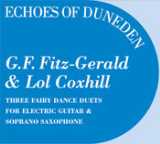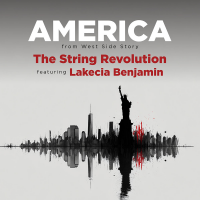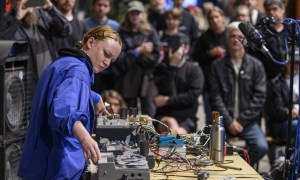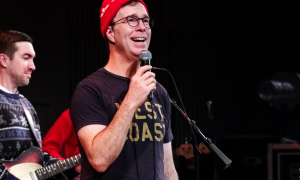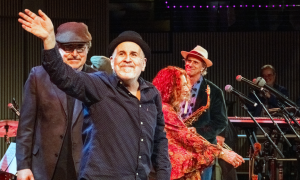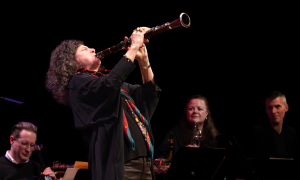Home » Jazz Articles » Live Review » Art of Jazz Celebration 2008: A Tale of The Sorcerer and...
Art of Jazz Celebration 2008: A Tale of The Sorcerer and The Storyteller
The Storyteller and the Sorcerer dropping by to the same venue, on the same day? What are the chances?
Hermeto Pascoal and Sheila Jordan, center-stage at the Art of Jazz Celebration
It was billed as "The Global Village": A place where jazz legends, lions and lovers come together to explore rhythmic intricacies and tonal colors from all over the map... where jazz is everywhere and freedom of expression, creativity and no fixed beat are the only rules on the street... And indeed it was, promising— with the dawn of each new day—to become even more so! Far less bourgeois, far more bohemian... in an atmosphere where time had almost stood still... and waited for Sheila Jordan and Steven Kuhn to duo unforgettably, as Randy Weston and Billy Harper had done just a day earlier, and Hermeto Pascoal would once again rejoin his old friend, Jovino Santos Neto, conducting the Art of Jazz Orchestra, playing Pascoal's wildly original music. The Storyteller and the Sorcerer dropping by to the same venue, on the same day? What are the chances?
But it simply had to be done. Any one who is in love with the vocal arts had to fall prey to the charms of Sheila Jordan, who—with Abbey Lincoln—must be the last of the great griots, the great storytellers of our music... So, she just had to be here with us, said Bonnie Lester, President of Art of Jazz, who together with Jane Bunnett and Larry Cramer (Artistic Directors of the 2008 Celebration) were responsible for inviting the stars of the Celebration. And who better to grace the stage to put the art of storytelling in song that Sheila Jordan! (Abbey Lincoln will be in Canada in July, though at the Festival in Montreal)!
Nominating the National Honoree for the Lifetime Achievement Award was easy: John Norris had no competition. But the International Honoree for the 2008 Celebration was a completely different story. The Panel of Judges could not decide between Egberto Gismonti and Hermeto Pascoal... So they decided to honor both! Small wonder why... Both Gismonti and Pascoal have genius beyond category. Both multi- instrumentalists and have been using their skill and passion to bring to audiences around the world some of the most spectacular music that knew no boundaries between classical and folk, popular and serious. Pascoal worked with Airto Moreira, Elis Regina, Edu Lobo, Cesar Camargo Mariano and Jovino Santos Neto... then Miles Davis. He used toys and teapots with accordions, guitars and saxophones to make music. Gismonti spent almost two decades in Paris studying orchestration and analysis with the legendary Nadia Boulanger and Jean Barraque, who was a disciple of Arnold Schonberg and Anton Webern. A pianist with sublime technique, he also taught himself to play guitar—to express his music—then revolutionized that instrument by turning it from a six to a ten-stringed instrument, on which he plays chords, and single notes and percussion—all at once—and with both hands! And for those who like trivia, he did this long before Jordan, Hunter, and Van Halen. Perhaps only Jimi Hendrix did more, technically, for the instrument than Gismonti continues to do!
June 07 was to be The Night that the Sorcerer, O Bruxo, was going to light up the Toronto sky with a selection of his music that had once left even Miles Davis so at a loss for words that, having invited Pascoal to join his band for Live/Evil, he could manage to say simply that Hermeto Pascoal was "one of the most impressive musicians in the world!" Hardly the words one would use to describe someone whose music is impossible to categorize and who has made it almost a religious ritual to fly in the face of convention, seemingly for the "heck of it!" But beneath it all is the soul of an artist for whom breaking barriers is de rigueur, and "making it new" a gospel!
The afternoon, however, belonged to Sheila Jordan and Steve Kuhn, as they graced the Dancemakers' Studio, an acoustically wonderful loft in the Distillery's Building 74. Jordan is one of two surviving American griots, storytellers who live the music and have adapted the epic storytelling manner, incorporating the blues, which incidentally seems to bubble in their arteries and veins! Abbey Lincoln is the other singer whose music appears to traverse many lifetimes in three or four or five short minutes. Today the griot tradition exists only in cultures where Western Civilization has not tainted those cultures beyond recognition—on the African continent, for instance. Jordan brings to the music a life lived as large as Bird and Dizzy and Max Roach and Bud Powell and Abbey Lincoln. Her Native American Heritage, years in Detroit, then in mining towns of Pennsylvania before making the jazz pilgrimage to New York in search of Bird gives her that distinctive voice. One to whom pitch is unimportant as long as the music speaks to the heart and appeases the Spirit. Her voice is truly God-given. It is a voice that does not seem to reside in her body, but somewhere in a spiritual space, waiting to be summoned down in song, to narrate heartache and joy in a life gloriously lived— communicating the blues in the idiom of jazz! For Jordan this is specially unique as she imbues that Native sensibility of communing with The Great Spirit, which enables her to hang a note on a sound of varying pitch, hold it and wobble it and, in just one breath, turn deep sorrow into pure joy, with such a subtle change in inflection that you can hear this only with your heart!
Sheila Jordan found at a very early age that loneliness and heartache could be overcome by singing. When she was a child in Pennsylvania, she heard bebop music and Charlie Parker in particular. "This is what I want to do," she said. And she proceeded to study harmony and theory with Lennie Tristano and Charles Mingus. Legend has it that Charlie Parker wrote, "Chasin' the Bird" for her, as she and her friends were known to follow him around in the 1940s. Jordan immortalized this story in "Sheila's Blues," which she performed at the Dancemakers' Studio to an audience that she had moved more often than not, in tears of joy! Jordan pioneered the art of the duo, singing first with Mingus, one night at a club in New York, then Arild Anderson, whom she met when teaching at City College in 1975... The album was Sheila, and it immortalized the Voice/Bass Duo sessions with her take on Parker's "Confirmation." Later she also performed with Harvey S and then—after meeting him on gigs with the trombonist, Roswell Rudd—the irrepressible bassist Cameron Brown. Her most celebrated recordings were made (and she continues to make them) with Brown, including I've Grown Accustomed to the Bass. In the mid 1970s Jordan also met Steve Kuhn and began a long working relationship with one of the finest pianists in jazz.
Sheila Jordan and Steve Kuhn crafted one of the 2008 Art of Jazz Celebration's finest performances, with songs sung from decades of music. The heart did stop beating and started listening when Jordan sang her immortal composition "Jazz Child," a principally wordless tune based on changes that glide telescopically into each other as a range of emotions abound in the room where it is sung. (There is a poem, written in tribute to Jordan, by Marria Banks) and Jordan and Kuhn, well...immoprtalized this song on the eponymous album (HighNote, 1998). The second set at this Duo session began with a solo flight by Kuhn, and fly he did, like Icarus, close to the sun, but melting hearts—not wax, as the mythical figure did. Chaplin's "Smile" rendered in the purist Lydian mode, and Sonny Rollins' "Airegin," which featured Kuhn making breathtaking excursions into the heart of jazz. Jordan rejoined Kuhn to complete the performance, and she added her irrepressible humor to the proceedings with her rendition of Steve Kuhn's "The Zoo," which would have upstaged Dave Frishburg completely. And, just when you thought it was safe to put away your handkerchief, Jordan returned with "The Moon's a Harsh Mistress." Grown men have been known to cry, especially when the other Jimmy—Little Jimmy Scott—sang "Motherless Child..." and now Sheila Jordan and the song that she sang, Jimmy Webb's wry tale of pain. Sheila Jordan will turn eighty later this year. She is a rare treasure, and every fan of the music needs have a good listen every time she stops by to sing her songs from the great Book of Life.
How could anyone top that? The best thing was not even to try! Or better still would be to step back and hand proceedings over to Hermeto Pascoal. The Sorcerer, as he is called, is regarded by many musicians as one of the few geniuses in the art of music. Pascoal is known for his skill in making music from even the most seemingly mundane objects—those, that is, not even associated with making music—such as kettles and plastic toys. Born in Arapiraca, in the countryside of Alagoas in Northeast Brazil, he moved several times—first to Recife, capital of Pernambuco, then to Rio De Janeiro and finally to Sao Paolo—where he joined forces with Airto Moreira—to set in motion music that has come to be some of the most original and unforgettable ever to have been made anywhere. In the 1970s he was invited to tour the United States with Airto, where the two made the album, Live/Evil with Miles Davis.
In the group, Quarteto Novo, cultures collided—the baiao from Northeastern Brazil and contemporary jazz from North America. Pascoal not only wrote and played music for Novo, but he also built many of the instruments that he played. In the late 1970s he formed his own bands and worked ceaselessly all over the world. Other members of Pascoal's entourage have included bassist, Itibere Zwarg, percussionists Nene, Pernambuco and Zabele and pianist Jovino Santos Neto. His latest group is a duo—Chimarrao com Rapadura, in which he plays off wife and multi-instrumentalist, Aline Morena. For the 2008 Celebration concert, Pascoal was joined by old cohort, Jovino Santos Neto, who conducted the Art of Jazz Orchestra, including such stars of Toronto, David Virelles on piano and Reg Schwager on guitar.
Hermeto Pascoal and his friends exploded on the stage of the Fermenting Cellar, literally, with a free-leading intro into "O Som do Sol" on which Reg Schwager excelled. The Hermeto Pascoal Big Band dived straight into "Brazil Universo," an extravagant opus from divergent musical perspectives that mirrored Brazil's wildly various cultures meld into one rhapsodic "tropicalista" paradise! At the heart of the first set was "Obrigado Mestre" and also "Viva Gil Evans," which worked the tonal values of each of the instruments like only Evans did with his various bands! It was not hard to see how Gil Evans, with his worldly view, was able to impress Pascoal enough to elicit a tribute from him. The Human Diaspora rather than the confines of any one culture inspires both musicians, and so their artistic palette has come to be—literally—the world! By now it appeared that nothing could top the set, and the well-deserved intermission was eminently appropriate—if only to just breathe and take it all in, before the second set and Pascoal's Big Band expedition took the audience deeper into its journey of discovery!
"Piramide" presented its dense, geometric web of sound, and "Valsa Nova" was—with the soloing members of the Big Band—quite a revelation in composition and musicianship. And "Bebe" was tender, spectacular and a heedful of sound. No matter how you felt about each song, there was no denying that Hermeto Pascoal turned the Celebration on its head. It seemed that you could not approach music—and indeed all sound—in the same way as before! Our lives had changed in two hours, after giving ourselves over to the charms of O Bruxo, the beloved Sorcerer!
Day Three was—as Pliny once suggested to a student he was instructing in the art of statecraft, "Let us choke them with gold..."—a truly magnificent assault on the senses! It ended with the Hermeto Pascoal Big Band and the presentation of the Lifetime Achievement Awards to one of two International recipients. But in between there was much to hear and take in. The magnificent Jane Fair Quartet, with Jane Fair on soprano saxophone and music that inhabited the outer extremities of the art in the grand manner of Ornette Coleman and the whole harmolodic movement in jazz. Kellylee Evans and her quartet (on the Pure Spirits Stage)... Ms Evans would rival the charms of Erykah Badu! And the irrepressible music of Aline Morales and her band, that made Brazil resound in heart and head! And to think that many were heard to say after Salsa 'n Six and Luis Mario Ochoa closed out the night before, "Wonder what could top that...?" and, "There couldn't be better...!" Now this...!
Photo Credit
R. Alan Dunlop
Tags
PREVIOUS / NEXT
Support All About Jazz
 All About Jazz has been a pillar of jazz since 1995, championing it as an art form and, more importantly, supporting the musicians who make it. Our enduring commitment has made "AAJ" one of the most culturally important websites of its kind, read by hundreds of thousands of fans, musicians and industry figures every month.
All About Jazz has been a pillar of jazz since 1995, championing it as an art form and, more importantly, supporting the musicians who make it. Our enduring commitment has made "AAJ" one of the most culturally important websites of its kind, read by hundreds of thousands of fans, musicians and industry figures every month.


